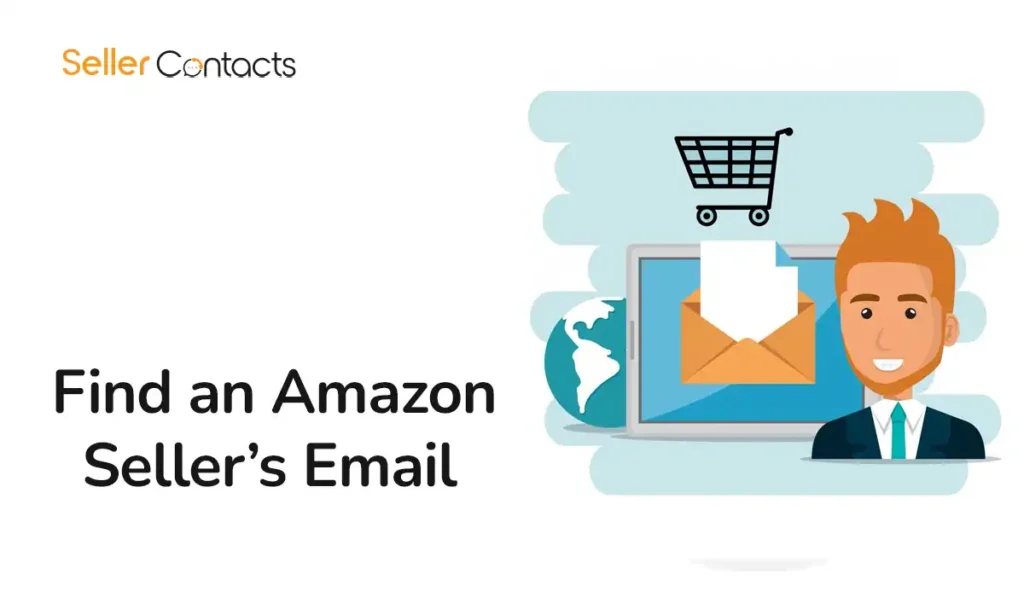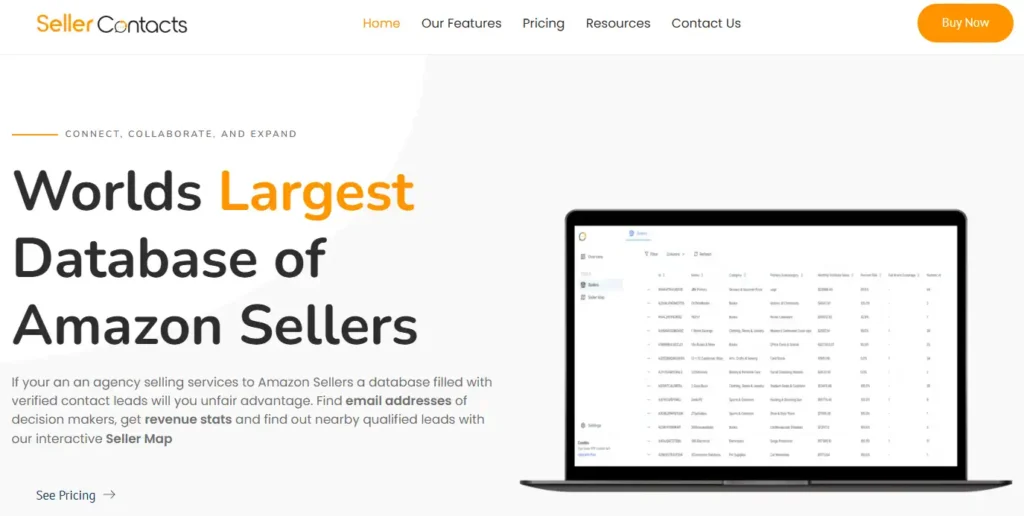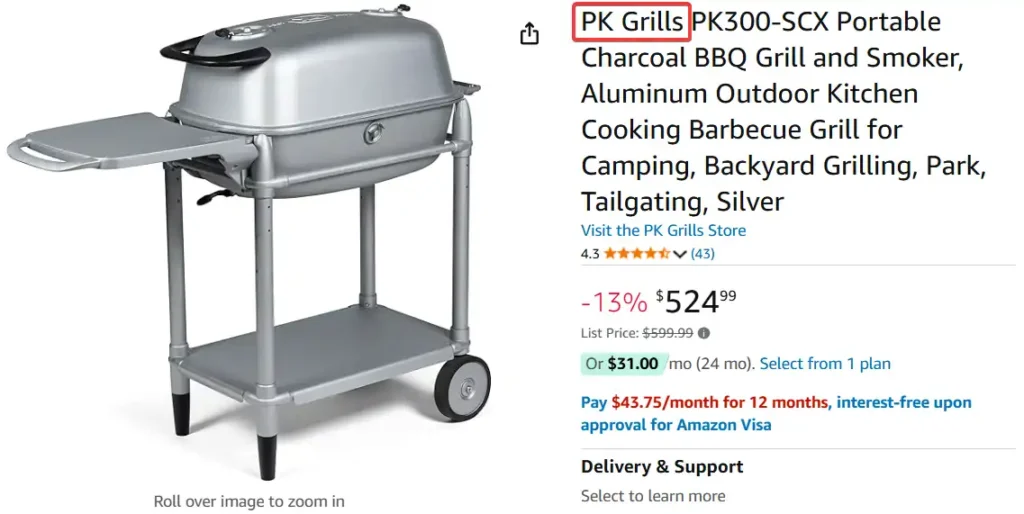How to Find an Amazon Seller’s Email

When you’re reaching out to an Amazon seller as a business owner, service provider, SaaS company, or for other professional purposes, finding their contact information can be challenging. Amazon restricts direct access to seller emails to protect user privacy. However, sellers often leave contact information across official channels, external platforms, and business websites. Here are specific strategies to help you connect with sellers outside Amazon’s marketplace.
1. Discover Amazon Seller Emails with SellerContacts
Finding Amazon seller emails for business partnerships, outreach, or SaaS services can be challenging, but SellerContacts simplifies the process. As the #1 Amazon seller database in the world, SellerContacts gives you access to the largest repository of Amazon seller data.
- 49+ data points: Verified emails, sales data, store URLs, and more.
- Search Filters: Find sellers by region, marketplace, or category.
- Global Seller Coverage: Unlock data across Amazon marketplaces worldwide.

This tool is perfect for service providers, agencies, or software businesses looking to scale their outreach. SellerContacts ensures you get actionable, verified seller information efficiently, saving time and maximizing ROI.
2. Check the Seller’s Storefront Profile for Contact Details
The seller’s storefront on Amazon is often the first place to look. Here’s how you can identify opportunities to find business contact information:
- Visit the Storefront: Click on the seller’s name from the product listing. This will take you to their seller profile page.

- Look for External Links: Some sellers include their website URL, social media profiles, or business email in their profile. This is most common for brands or large third-party sellers looking to build relationships.
- Scroll to the “About Us” Section: Certain sellers add brand information or promotional material with links to external pages, where you can often find direct contact options.
For example, a seller profile might include:
“Visit us at www.brandname.com for wholesale inquiries.”
Tip: Bookmark the seller’s official website for future reference, as they may offer different contact options for B2B opportunities, wholesale, or partnerships.
3. Use Amazon Brand Registry for Recognized Brands
If the seller operates a registered brand under the Amazon Brand Registry program, you can find additional information about their business. Sellers often register trademarks and link their brand name to a business profile or external page where emails are more accessible.
Steps to check this:
- Visit the product listing.
- Look for the brand name near the title (e.g., “Sold by BRAND NAME”).

- Search the brand name online to locate their official website or contact form.
For instance, a registered seller might promote their brand outside Amazon:
“For partnerships or wholesale requests, visit our website or email us at [email protected].”
4. Search for the Seller Online
Many Amazon sellers have websites, LinkedIn profiles, or social media pages where they promote their products and services. Use these methods to uncover direct contact details:
A. Use Google to Find Seller Information
Search the seller’s business name or brand in Google. Try variations like:
- “[Brand Name] official website”
- “[Brand Name] contact email”
- “[Brand Name] wholesale”

If their website appears, go to the Contact Us or About page. Most businesses will have a general email or a contact form for partnerships, B2B requests, and service inquiries.
Example Google Search:
- Searching for “EcoSeller contact email” may lead you to ecoseller.com/contact, where the seller’s B2B email is listed.
B. Check LinkedIn for Seller or Brand Profiles
Many sellers promote their products and brands on LinkedIn, making it a great tool for professional outreach.
Steps:
- Search for the seller’s brand name on LinkedIn.
- Look for company profiles or employees (e.g., CEO, Marketing Manager, or Sales Lead).
- Send a connection request or message with a clear, professional introduction.
Example:
“Hi [Name], I noticed you manage [Brand Name] on Amazon. I run a service that helps sellers optimize their listings. Would you be open to a quick call?”
C. Check Social Media Profiles
Sellers often promote their businesses on platforms like Instagram, Facebook, and Twitter. They may include business contact details in their bio or about sections.
- Instagram bio: “Contact us for wholesale inquiries at [email protected].”
- Facebook business page: Direct contact forms, phone numbers, or email links.
5. Use WHOIS Lookup for Seller-Owned Websites
If you find the seller’s website but can’t locate a contact email, you can use a WHOIS lookup tool to retrieve their domain registration information. While this may not always yield an email, it can sometimes provide useful leads.
Steps:
- Visit WHOIS tools like whois.domaintools.com.
- Enter the seller’s website domain.
- Look for a registrant email or business contact email.

Note: Some sellers may use privacy protection services, which mask their WHOIS information.
6. Contact Amazon Seller Support for Large-Scale Business Inquiries
If you’re unable to locate a seller’s contact details and need to inquire about bulk purchases, partnerships, or wholesale, you can request Amazon Seller Support to facilitate contact.
While Amazon won’t share the seller’s email, they can forward your inquiry to the seller on your behalf. Here’s what to do:
- Use the Buyer-Seller Messaging System to introduce your business inquiry.
- Request the seller to respond with a direct email if they’re interested in discussing further.
Example Message:
“Hi [Seller Name], I represent [Your Company] and would love to discuss potential wholesale opportunities for your [product]. Please reply at your convenience, or let me know if there’s a better way to connect.”
Things to Keep in Mind When Reaching Out
- Respect Amazon’s Privacy Policies: Avoid asking for emails directly within Amazon’s system, as it violates platform rules. Use external methods for professional outreach.
- Be Professional: Always introduce yourself and your business clearly. Explain why you’re reaching out and how it benefits the seller.
- Follow Up: If you don’t get a response after a week, send a polite follow-up message or try an alternative platform like LinkedIn.
Final Thoughts
Finding an Amazon seller’s email for business purposes requires resourcefulness and a strategic approach. By leveraging the seller’s storefront, official website, social media platforms, and tools like Google Search or LinkedIn, you can often uncover their contact information. While Amazon prioritizes privacy, sellers running growing businesses are typically open to professional opportunities, whether it’s for wholesale, partnerships, SaaS tools, or services that benefit their brand.
Keep your outreach polite, professional, and value-driven to make a strong impression. By combining these methods, you can establish meaningful connections with Amazon sellers and explore successful business opportunities.
